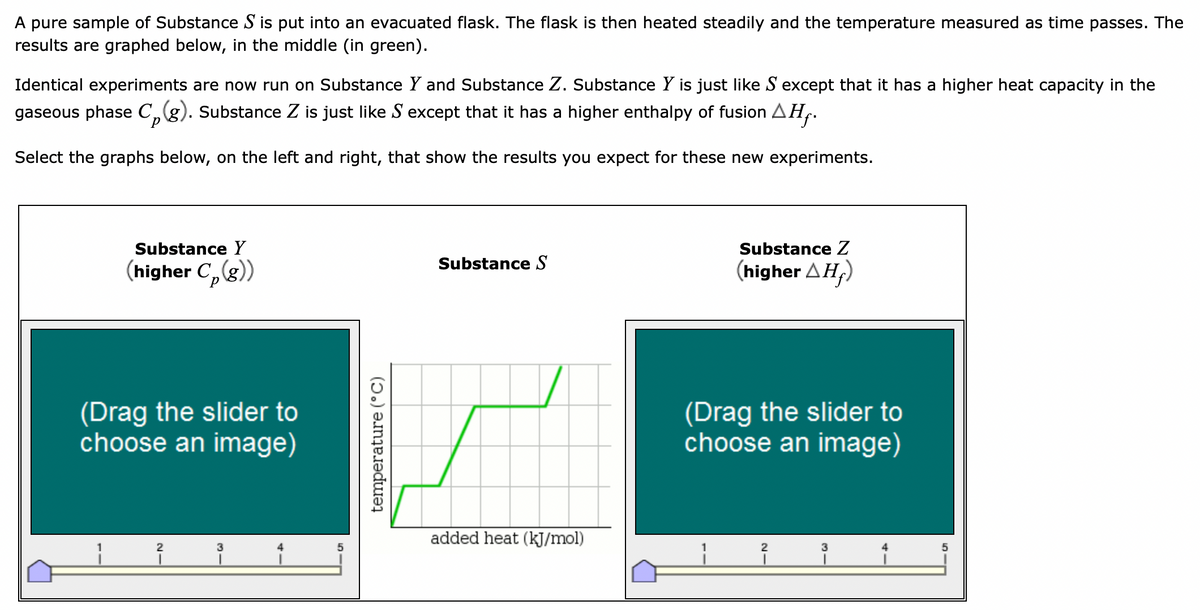A pure sample of Substance S is put into an evacuated flask. The flask is then heated steadily and the temperature measured as time passes. The results are graphed below, in the middle (in green). Identical experiments are now run on Substance Y and Substance Z. Substance Y is just like S except that it has a higher heat capacity in the gaseous phase C„(g). Substance Z is just like S except that it has a higher enthalpy of fusion AHf. Select the graphs below, on the left and right, that show the results you expect for these new experiments. Substance Y Substance Z Substance S (higher C,(g)) (higher AH;) (Drag the slider to choose an image) (Drag the slider to choose an image) added heat (kJ/mol) 3 4 1 2 3 4 temperature (°C)
A pure sample of Substance S is put into an evacuated flask. The flask is then heated steadily and the temperature measured as time passes. The results are graphed below, in the middle (in green). Identical experiments are now run on Substance Y and Substance Z. Substance Y is just like S except that it has a higher heat capacity in the gaseous phase C„(g). Substance Z is just like S except that it has a higher enthalpy of fusion AHf. Select the graphs below, on the left and right, that show the results you expect for these new experiments. Substance Y Substance Z Substance S (higher C,(g)) (higher AH;) (Drag the slider to choose an image) (Drag the slider to choose an image) added heat (kJ/mol) 3 4 1 2 3 4 temperature (°C)
Chemistry: Principles and Reactions
8th Edition
ISBN:9781305079373
Author:William L. Masterton, Cecile N. Hurley
Publisher:William L. Masterton, Cecile N. Hurley
Chapter8: Thermochemistry
Section: Chapter Questions
Problem 74QAP: In 2010, 3.30109 gallons of gasoline were consumed in the United States. The following assumptions...
Related questions
Question
Interpreting a heating curve.

Transcribed Image Text:A pure sample of Substance S is put into an evacuated flask. The flask is then heated steadily and the temperature measured as time passes. The
results are graphed below, in the middle (in green).
Identical experiments are now run on Substance Y and Substance Z. Substance Y is just like S except that it has a higher heat capacity in the
gaseous phase C„(g). Substance Z is just like S except that it has a higher enthalpy of fusion AHf.
Select the graphs below, on the left and right, that show the results you expect for these new experiments.
Substance Y
Substance Z
Substance S
(higher C,(g))
(higher AH;)
(Drag the slider to
choose an image)
(Drag the slider to
choose an image)
added heat (kJ/mol)
3
4
1
2
3
4
temperature (°C)
Expert Solution
This question has been solved!
Explore an expertly crafted, step-by-step solution for a thorough understanding of key concepts.
This is a popular solution!
Trending now
This is a popular solution!
Step by step
Solved in 2 steps with 1 images

Knowledge Booster
Learn more about
Need a deep-dive on the concept behind this application? Look no further. Learn more about this topic, chemistry and related others by exploring similar questions and additional content below.Recommended textbooks for you

Chemistry: Principles and Reactions
Chemistry
ISBN:
9781305079373
Author:
William L. Masterton, Cecile N. Hurley
Publisher:
Cengage Learning

Principles of Modern Chemistry
Chemistry
ISBN:
9781305079113
Author:
David W. Oxtoby, H. Pat Gillis, Laurie J. Butler
Publisher:
Cengage Learning

Chemistry: The Molecular Science
Chemistry
ISBN:
9781285199047
Author:
John W. Moore, Conrad L. Stanitski
Publisher:
Cengage Learning

Chemistry: Principles and Reactions
Chemistry
ISBN:
9781305079373
Author:
William L. Masterton, Cecile N. Hurley
Publisher:
Cengage Learning

Principles of Modern Chemistry
Chemistry
ISBN:
9781305079113
Author:
David W. Oxtoby, H. Pat Gillis, Laurie J. Butler
Publisher:
Cengage Learning

Chemistry: The Molecular Science
Chemistry
ISBN:
9781285199047
Author:
John W. Moore, Conrad L. Stanitski
Publisher:
Cengage Learning

Chemistry for Engineering Students
Chemistry
ISBN:
9781337398909
Author:
Lawrence S. Brown, Tom Holme
Publisher:
Cengage Learning

General Chemistry - Standalone book (MindTap Cour…
Chemistry
ISBN:
9781305580343
Author:
Steven D. Gammon, Ebbing, Darrell Ebbing, Steven D., Darrell; Gammon, Darrell Ebbing; Steven D. Gammon, Darrell D.; Gammon, Ebbing; Steven D. Gammon; Darrell
Publisher:
Cengage Learning

Chemistry
Chemistry
ISBN:
9781305957404
Author:
Steven S. Zumdahl, Susan A. Zumdahl, Donald J. DeCoste
Publisher:
Cengage Learning